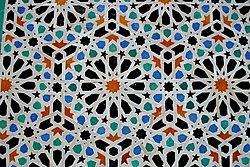infinity
The term infinity denotes the negation or abolition of finitude, less precisely also its opposite . Its mathematical symbol is the infinity sign . Theoretically, the term “infinite” describes an object (e.g. a sphere ) or a process with no end or end, but possibly with a beginning or a beginning. In geometry , a ray or a circular path would be described as infinite.
The “concept of infinity” found more precise expression in mathematics , essentially initiated by the work of Bernard Bolzano , Georg Cantor and Richard Dedekind , which led to set theory and in particular to the theory of infinite sets and transfinite cardinal numbers . In particular, he was also for the first time expanded to include properties that cannot be derived from the negative definition above.
Methodical approaches
Infinity can only be developed abstractly in the humanities or natural sciences and is applied to objects and concepts that have no spatial and / or temporal limits .
In theology and some philosophical conceptions (such as natural theology ), infinity is one of God's attributes , while creation is finite per se. The essence of the infinite is especially a topic of metaphysics and mysticism , for example in the Kabbalah under the name En Sof or with Christian mystics like Nikolaus von Kues and Meister Eckhart .
In the philosophy existed since Aristotle two conceptions of the concept of infinity: the "actual infinity" and the "potentially infinite" . The scholasticism distinguishes accordingly between the potential infinity ( "the indefinite"), which can be propagated without end, and the actual infinite ( "infinite") that excludes any limit positive. In the narrow and proper sense, only God has actual infinity. It is the limitless fullness of being, but not to be misunderstood in a pantheistic sense.
Hegel coined the term “bad infinity” ( encyclopedia § 93 f.), By which he understands in a dialectical way a demarcation from finitude.
In astronomy , given the depth and breadth of the starry sky , the idea of an infinitely extensive space has often been developed.
The concept of infinity is also known in relation to time , here the term eternity is used . While higher mathematics often operates with the abstract “infinite”, in theoretical physics the phenomenon of singularity is more important - for example in connection with the terms big bang (beginning of the visible universe ) and black hole . A singularity is a point in space-time where mass is concentrated in an expansionless point with infinite density .
In addition to the infinite extension to ever-increasing sizes of the term is also used for the infinite divisibility , whose border that uses infinite Fine zero is zero but does not reach. The original Greek " atomic theory " of the "indivisible" resulted from the negation of the infinitely fine and its paradoxes .
Infinity in math
In mathematics, "infinity" is the name given to the infinity axiom of set theory. Usually, however, the adjective infinite is used to further characterize some mathematical terms; as a rule, this characterization is complementary to the term finite .
Symbolism and art
The infinity sign , introduced in 1655 by the English mathematician John Wallis , is also used outside of science and technology and is widespread in everyday context. The circle and sphere have always been considered symbols of the limitlessness and infinity of the cosmos. The potentially endless ornaments of Islamic Art (z. B. tile mosaics , Jali- or MASHRABIYA lattices and to Artesonado -Holzdecken) must be mentioned in this context. Leonardo da Vinci symbolized infinity with the infinity machine . The painter Caspar David Friedrich placed a monk in front of the infinity of the sea . The Dutch draftsman MC Escher dealt with the subject in a different way ( perpetual motion machine or trompe-l'oeil effects) .
See also
- En Sof - in Jewish mysticism
literature
- Amir D. Aczel: The nature of infinity. Math, Kabbalah and the secret of the Aleph. Rowohlt-Taschenbuch-Verlag, Reinbek near Hamburg 2002, ISBN 3-499-61358-1 ( rororo - science 61358).
- Herbert Beckert : To the knowledge of the infinite. Hirzel et al. a., Stuttgart a. a. 2001, ISBN 3-7776-1136-0 ( Treatises of the Saxon Academy of Sciences in Leipzig 59, 3).
- Heinz-Dieter Ebbinghaus : Introduction to set theory . 3rd, completely revised and expanded edition. BI-Wissenschaftsverlag, Mannheim (inter alia) 1994, ISBN 3-411-17113-8 .
- Rudolf Eisler : Infinite . In: Dictionary of Philosophical Terms . 1904 (with sub-items)
- Adolf Fraenkel : Introduction to set theory (= The basic doctrines of the mathematical sciences in individual representations . Volume 9 ). 3rd, revised and greatly expanded edition. Springer Verlag, Berlin (among others) 1928.
- Hans Lauwerier: Infinity. Thinking in the limitless. Rowohlt-Taschenbuch-Verlag, Reinbek near Hamburg 1993, ISBN 3-499-19384-1 ( rororo - rororo-Sachbuch - rororo science 9384).
- Ludwig Neidhart: Infinity at the intersection of mathematics and theology . Cuvillier, Göttingen 2007, 2nd edition 2008, ISBN 978-3-86727-588-0
- Eli Maor : To Infinity and Beyond. A Cultural History of the Infinite. Birkhäuser, Boston a. a. 1987, ISBN 0-8176-3325-1 .
- Raymond Smullyan : Satan, Cantor and Infinity and 200 other amazing tinkering. Insel-Verlag, Frankfurt am Main a. a. 1997, ISBN 3-458-33599-4 ( Insel-Taschenbuch 1899).
- Paolo Zellini: A Brief History of Infinity. CH Beck, Munich 2010, ISBN 978-3-406-59092-4 .
Web links
Individual evidence
- ↑ Shaughan Lavine: Understanding the infinite . Harvard University Press, Cambridge, MA 1994, pp. 181 .


